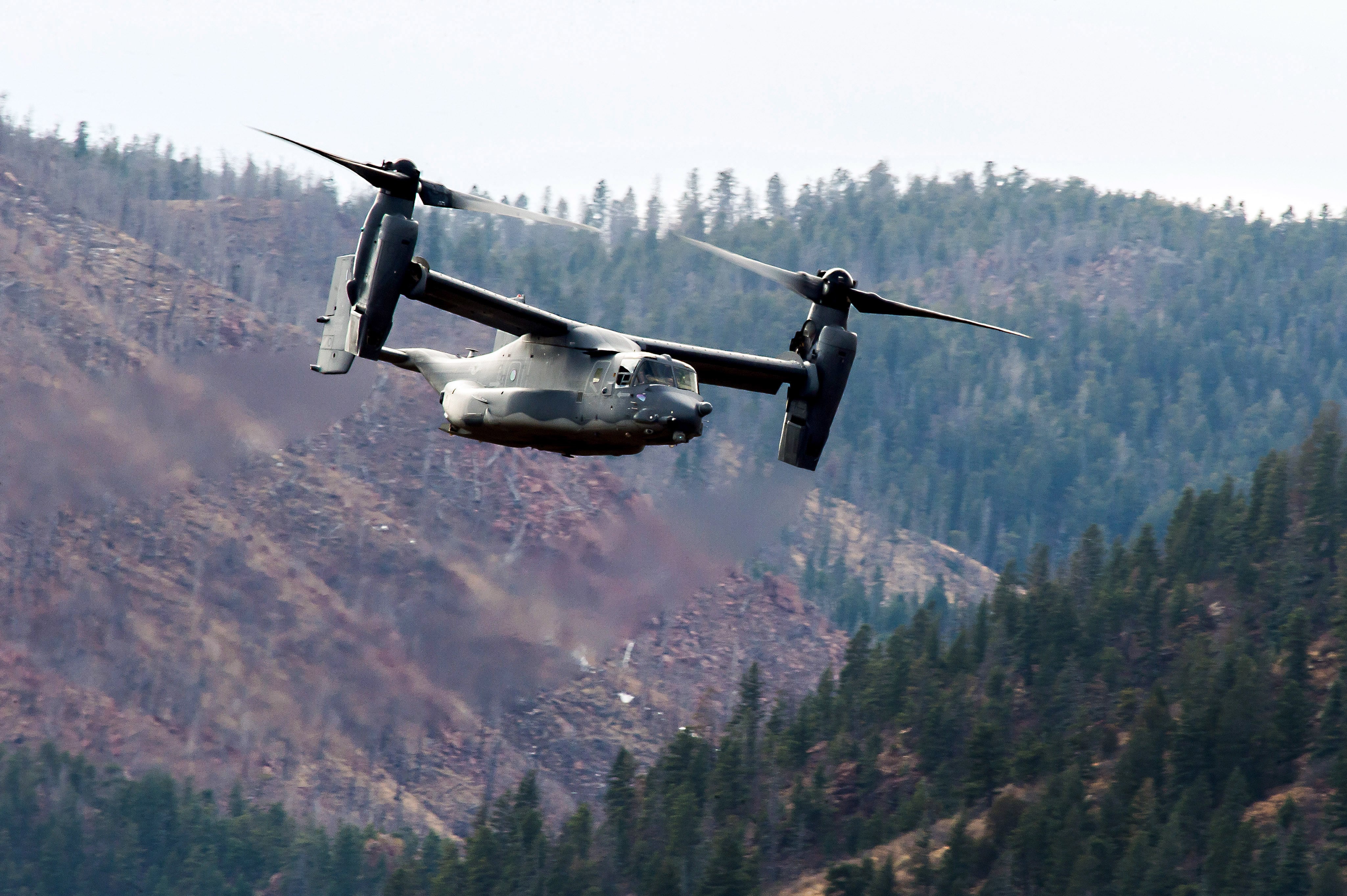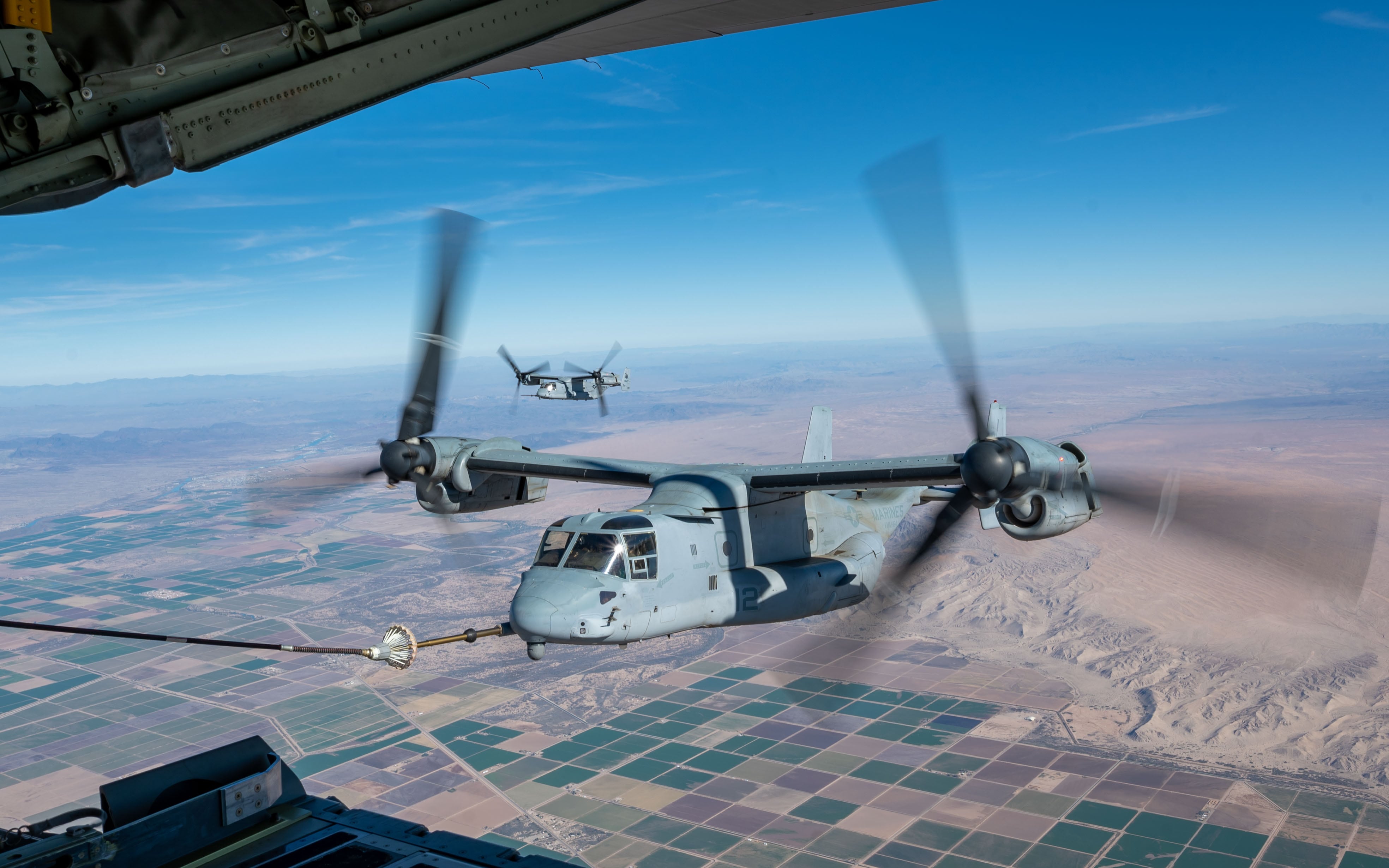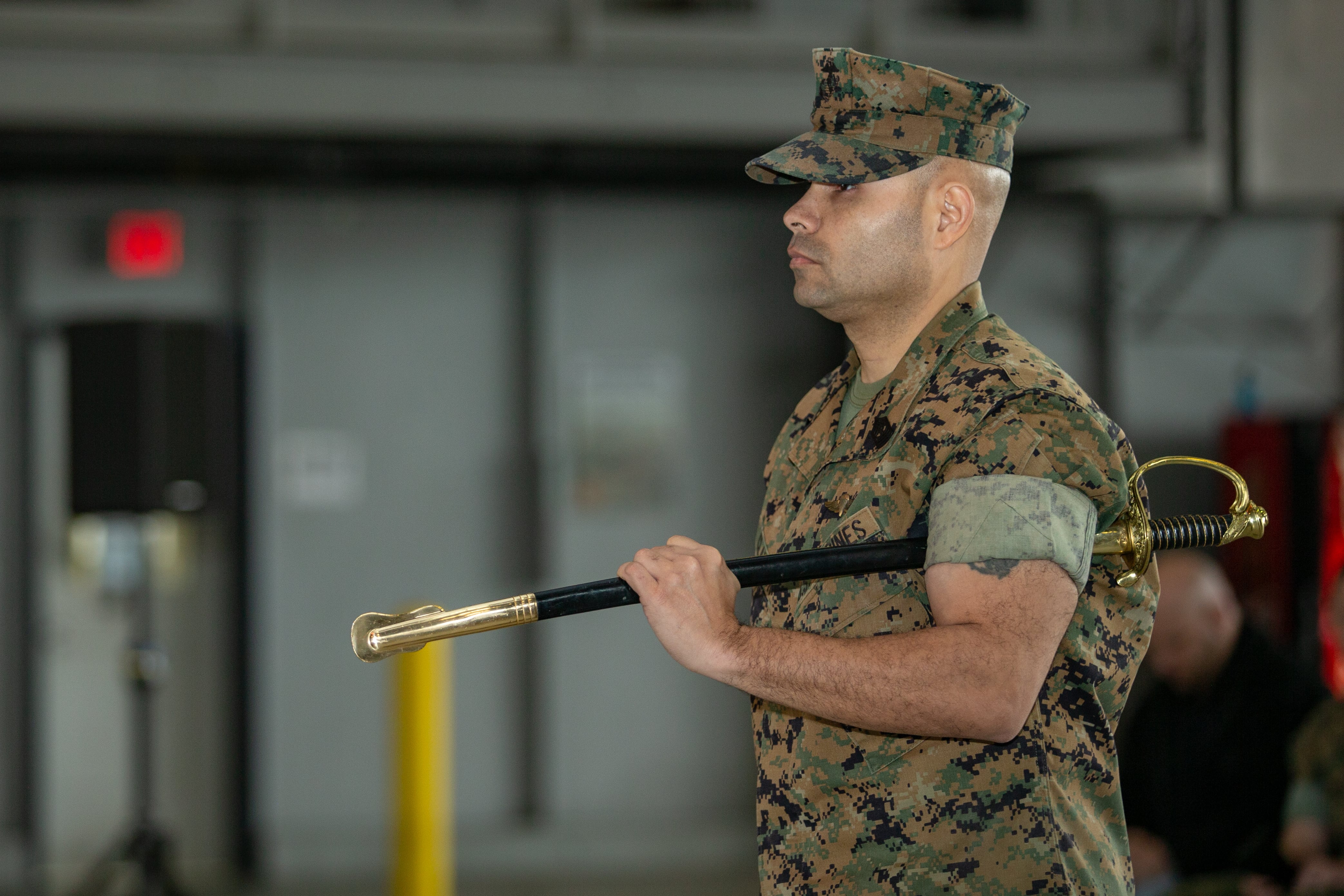The U.S. military will allow its fleet of V-22 Ospreys to fly again, three months after it grounded the entire inventory of more than 400 aircraft following a fatal crash off the coast of Japan in November.
The Marine Corps, Air Force and Navy will immediately start refreshing troops’ training and changing maintenance procedures as prerequisites for resuming normal operations, leaders from each of the services told reporters Wednesday.
But they acknowledged it will be months before the tiltrotor aircraft are fully back to flying real-world missions.
The Ospreys will receive no equipment modifications before they return to the air.
RELATED

Marine Corps Col. Brian Taylor, the V-22 joint program manager, told reporters his office and the services “have high confidence that we understand what component failed and how it failed.” It’s still unclear why the part in question did not perform as intended.
Taylor and other service officials declined to say which component’s failure caused an Air Force Special Operations Command Osprey to crash into the sea during a training mission Nov. 29, killing all eight airmen aboard. They also declined to answer whether the aircraft would be restricted from flying under certain conditions or in certain areas due to the risk of a repeat problem.
The accident is still under investigation. The Air Force has shared its findings with the joint program office — which manages V-22 acquisition and maintenance for the Air Force, Navy and Marine Corps — and the other services to better understand the material failure that led to the crash.
Because the wreckage of the Osprey sat under the Pacific Ocean for about a month before being recovered, the drive system is corroded such that engineers may never understand why the unnamed component failed, Taylor said. But investigators created a “fault tree” to map out potential causes, which are addressed in the services’ mitigation plan.
The main change will increase the frequency of an inspection that is already done on the aircraft — like upping the number of oil changes on a car, Taylor said. He said the change gives the component a greater “perimeter of safety” during operations.
Though Taylor repeatedly declined to offer information about the component, he said it is not the input quill assembly that attaches the Osprey’s engine to its proprotor gear box — the component that began wearing out early and caused a series of clutch malfunctions for Marine Corps and Air Force pilots in 2022. A portion of the Air Force and Marine Corps fleets were grounded in 2023 as those services studied how to mitigate the risk of so-called “hard clutch engagements” and when to replace worn-out parts.
NBC reported Feb. 19 the November crash may have involved “chipping,” where tiny pieces of metal wear off during use and can damage the engine. Taylor did not specify whether chipping played a role in the crash, but characterized it as a normal phenomenon for a mechanical system and said the V-22 has a sophisticated monitoring system that looks for small metal bits and alerts the pilot if any are detected.
Taylor made clear the November crash was unrelated to other previous V-22 mishaps.
“This is the first time that we’ve seen this particular component fail in this way, and so this is unprecedented” in the 750,000 flight hours amassed over the life of the V-22 program, he said.
Due to that long track record, Taylor said: “We are confident in the system.”
The ‘Gundam 22′ crash
The Nov. 29 accident was the deadliest Air Force mishap since 2018, and the fourth fatal Osprey crash in a two-year span. Twenty U.S. troops have died in Osprey incidents since March 2022.
The downed crew of “Gundam 22″ included Osprey pilots Maj. Jeff Hoernemann, Maj. Luke Unrath and Capt. Terry Brayman; medical personnel Maj. Eric Spendlove and Tech. Sgt. Zach Lavoy; flight engineers Staff Sgt. Jake Turnage and Senior Airman Kody Johnson; and airborne linguist Staff Sgt. Jake Galliher.
Six were stationed at Japan’s Yokota Air Base; two worked at Kadena Air Base. All were assigned to the Air Force’s 353rd Special Operations Wing.
The weeks-long, multinational search effort successfully recovered the bodies of all but Spendlove.
The U.S. military now flies hundreds of V-22s, largely operated by the Marines. The tiltrotor aircraft is known for its towering nacelles that allow it to launch and land like a helicopter, and speed forward like a fixed-wing plane. Troops use the unique aircraft to slip in and out of areas without established runways, where fixed-wing planes may not be able to land with troops and supplies.
The Marine Corps owns nearly 350 Ospreys; the Air Force and Navy operate smaller fleets at around 50 and 30 aircraft, respectively.
Beyond the safety and accident investigation boards studying the most recent crash, Air Force Special Operations Command is also conducting a deep-dive into its CV-22 Osprey program to determine whether it provides adequate training, resources and other factors to ensure airmen’s safety.
The Government Accountability Office and House Committee on Oversight and Accountability have also launched their own probes into the V-22. On Wednesday, Rep. James Comer, a Kentucky Republican who chairs the House oversight committee, said it had not yet received information from the military as it looks into the aircraft’s safety and performance.
“Serious concerns remain, such as accountability measures put in place to prevent crashes, a general lack of transparency, how maintenance and operational upkeep is prioritized, and how DOD assesses risks,” Comer said in a statement. “We will continue to rigorously investigate the DOD’s Osprey program to attain answers to our questions on behalf of American taxpayers and protect U.S. service members defending our nation.”
Marines prepare
As the biggest user of the V-22 platform by far, the Marine Corps has been most affected by the monthslong grounding. It relies on the Osprey to move people, supplies and weapons, and operates from ship decks and from ground bases.
Brig. Gen. Richard Joyce, the assistant deputy commandant for aviation, told reporters the Marine Corps has focused on keeping up troops’ proficiency on the Osprey since the grounding began in early December so the service could resume flights as quickly as possible.
“Our simulator utilization has been maximized to keep proficiency as much as possible in the virtual environment,” he said.
The service has gone as far as sending MV-22 pilots in Djibouti thousands of miles away to use simulators in Japan, and shipping MV-22 pilots who are deployed to the Middle East with the 26th Marine Expeditionary Unit back home to North Carolina for simulator training.
Now that the program office has cleared the aircraft to fly, the Corps’ most experienced pilots and aircrew will begin maintenance-check flights to get the Ospreys up in the air, then retrain on “core and basic skills,” Joyce said. Once those top personnel have brushed up on the fundamentals, they’ll pair with junior pilots and crew for additional basic training.
Joyce said it would take about a month for a squadron to get everyone back up to speed basic skills.
However, it will take more time for the personnel to retrain on more advanced skills and mission-specific tasks for combat assaults, transport flights and other missions.
The general said it would take until late spring or early summer to get back to pre-grounding readiness levels.
V-22 squadrons will go through more consumable parts, like filters, as they take on additional inspections and maintenance, he said. Those parts and training support will first go to deployed units, followed by squadrons with upcoming deployments, squadrons participating in key exercises or service-level training events, and eventually to test-and-evaluation units and those farthest from a future deployment.
The amphibious assault ship Boxer and the 15th MEU are set to deploy from California this spring, and Joyce said it’s not clear yet if they’ll be ready to bring the V-22 along. It’s one of the most pressing decisions related to resuming V-22 flight operations, he said.
Air Force’s ongoing studies
Airmen have done the work required to keep the Air Force’s Osprey fleet healthy during the three-month standdown, but “there’s only so much they can do with aircraft that are not flying,” Air Force Special Operations Command boss Lt. Gen. Tony Bauernfeind told reporters Wednesday.
He described a 12-week road map to getting the Ospreys back in the air that adds new maintenance requirements and allows experienced airmen to lead the way. The service will deviate from that plan as needed if work isn’t progressing on schedule.
Returning the aircraft to service begins with ground and simulator training that will include new safety controls and briefings, a review of aircraft maintenance records and refining squadron-level training plans to implement the new safety protocols, Bauernfeind said.
The Air Force did not elaborate on what new safety protocols will be introduced. AFSOC held an all-hands for Osprey crews Feb. 22-23 at Hurlburt Field, Florida, to explain the new safety protocols.
“We received very positive feedback that it was very beneficial to the crews,” Bauernfeind said.
The second phase will focus on returning air crews and maintainers to basic proficiency, initially targeted at senior aviators, instructors, evaluators and weapons officers. Simulator training has helped keep skills sharp during the standdown.
The phased approach gives the service time to absorb findings from the service’s initial safety investigation, an internal report meant to root out the cause of a mishap and prevent future occurrences. Bauernfeind received and accepted the findings of the safety board March 1.
He expects it will take the service more than three months to reach the level of proficiency it had on the Osprey before the Nov. 29 crash.
Bauernfeind said he’s confident in the service’s ability to safely resume Osprey operations before wrapping up two ongoing investigations. The Air Force has kept the families of the downed crew informed about the process, but has not told them the results of the recently completed safety investigation board.
“I have confidence that we know enough now to return to fly,” he said.
Navy’s path to at-sea missions
The Navy will take a similarly cautious approach to resuming its flights, putting only its most experienced personnel in the air first for basic flights in daytime-only conditions, Commander of Naval Air Forces Vice Adm. Daniel Cheever told reporters.
Those top personnel will then pair with junior sailors and eventually resume night operations and other, more complex training. The Navy will lastly resume training new pilots and aircrew at the fleet replacement squadrons.
But Cheever warned that returning to flight wasn’t the same as returning to mission: It may be several more months until the Navy sees its CMV-22Bs flying operational missions to haul cargo and people to aircraft carriers at sea.
Cheever said the Navy would avoid long, over-ocean flights until all personnel had built up sufficient proficiency. But when asked about any restrictions on the aircraft regarding duration of over-water flights, he deferred to NAVAIR. Taylor, from the V-22 program office under NAVAIR, declined to say whether there were or were not any operational limitations for the planes under the new return-to-flight plan.
Cheever highlighted the Navy’s flexibility and said all carriers at sea had fared well during the V-22 grounding. The Navy relied on its C-2A Greyhound, which is set to sundown in 2026 as it’s replaced by the CMV-22B, to resupply carriers at sea, including the Theodore Roosevelt deployed in the Indo-Pacific today.
He said the Navy also relied more heavily on its replenishment ship fleet and looked to load more goods onto carriers when they were in port.
But he noted the importance of getting the CMV-22 back to its mission, saying it can conduct medical evacuations and haul large F-35C engine components — unlike its aging predecessor.
Megan Eckstein is the naval warfare reporter at Defense News. She has covered military news since 2009, with a focus on U.S. Navy and Marine Corps operations, acquisition programs and budgets. She has reported from four geographic fleets and is happiest when she’s filing stories from a ship. Megan is a University of Maryland alumna.
Courtney Mabeus-Brown is the senior reporter at Air Force Times. She is an award-winning journalist who previously covered the military for Navy Times and The Virginian-Pilot in Norfolk, Va., where she first set foot on an aircraft carrier. Her work has also appeared in The New York Times, The Washington Post, Foreign Policy and more.
Rachel Cohen is the editor of Air Force Times. She joined the publication as its senior reporter in March 2021. Her work has appeared in the Washington Post, the Frederick News-Post (Md.), Air and Space Forces Magazine, Inside Defense, Inside Health Policy and elsewhere.





